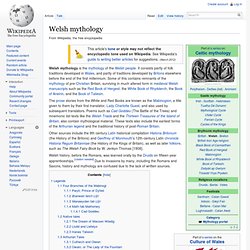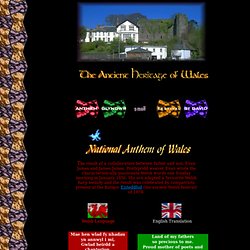

Welsh mythology. The prose stories from the White and Red Books are known as the Mabinogion, a title given to them by their first translator, Lady Charlotte Guest, and also used by subsequent translators.

Poems such as Cad Goddeu (The Battle of the Trees) and mnemonic list-texts like the Welsh Triads and the Thirteen Treasures of the Island of Britain, also contain mythological material. These texts also include the earliest forms of the Arthurian legend and the traditional history of post-Roman Britain. Other sources include the 9th century Latin historical compilation Historia Britonum (the History of the Britons) and Geoffrey of Monmouth's 12th-century Latin chronicle Historia Regum Britanniae (the History of the Kings of Britain), as well as later folklore, such as The Welsh Fairy Book by W.
Jenkyn Thomas [1908]. Welsh history, before the Romans, was learned orally by the Druids on fifteen-year apprenticeships. Legends[edit] Four Branches of the Mabinogi[edit] Pwyll, Prince of Dyfed[edit] Rhys ap Thomas. Soldier, knight, landowner, king-maker (1448-1525) The tomb of Rhys ap Thomas (1448-1525) in St.

Peter's Church, Carmarthen, with Rhys lying in effigy on top. After the Lord Rhys (Rhys ap Gruffudd, 1132-1197) Llandeilo's next most famous son is Sir Rhys ap Thomas (1448-1525). Not many towns can boast a citizen who killed a king of England in battle (if 'boast' is the appropriate word in this context) but Llandeilo can, because that is exactly what Rhys ap Thomas is supposed to have done on Bosworth field on August 22nd, 1485. Then, if one Welsh poet (Guto'r Glyn) is to believed, he dispatched King Richard III to the next world. In the process his kinsman Henry Tudor became Henry VII and inaugurated the golden age of the Tudor dynasty. The story of a Llandeilo landowner's rise to kingmaker and then Welsh top-dog is outlined in detail by Ralph A Griffiths in Sir Rhys ap Thomas and his Family (University of Wales Press, Cardiff, 1993), to which this article is much indebted.
Sources: Top. Ancient and Medieval Wales. During the last ice age people hunted reindeer and mammoth in what is now Wales.

When the ice age ended around 10,000 BC new animals appeared in Wales, such as red deer and wild boar. Stone age hunters hunted them both. They also gathered plants for food. In about 4,000 BC farming was introduced into Wales, although the people still used stone tools. About 2,000 BC people learned to use bronze. In 43 AD the Romans invaded Southeast England. Afterwards Wales was firmly under Roman rule. Christianity arrived in Wales in the 3rd century. However in the 4th century the Roman Empire went into decline.
Meanwhile the Saxons invaded eastern England. Then in the 9th century the Vikings began attacking Wales. A brief history of Conwy A brief history of Newport A brief history of Swansea A brief history of Wrexham A history of Wales Home. Welcome to Llandeilo. Wales - the ancient Celtic heritage. The National Eisteddfod of Wales is Europe's oldest and largest festival of culture, literature and indigenous music; its origins backdate to the 12th Century.

Every August, the attraction of Wales's National Eisteddfod draws 170,000 visitors over a week long event, which is best described as a Welsh cultural and artistic Olympics, a celebration of the Welsh love of art, literature and pageant. Throughout the year, local and regional Welsh Eisteddfodau qualify a total 6,000 competitors for the national event, which range from poets to choirs and musicians to artists. While the Eisteddfod is held at towns and cities alternately in northern and southern Wales, the institution is exclusively Welsh language orientated and provides a high profile focus and convergence of the Welsh speaking communities of Wales. The most coveted literary prize in the National Eisteddfod is the "chair" - indeed, the word "Eisteddfod" translates as "chairing" or "sitting".